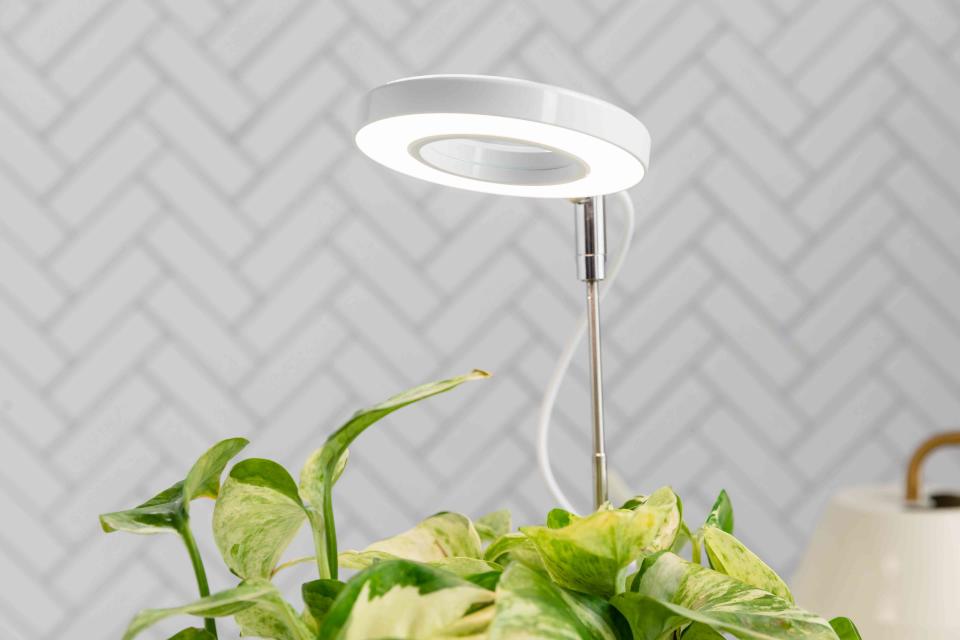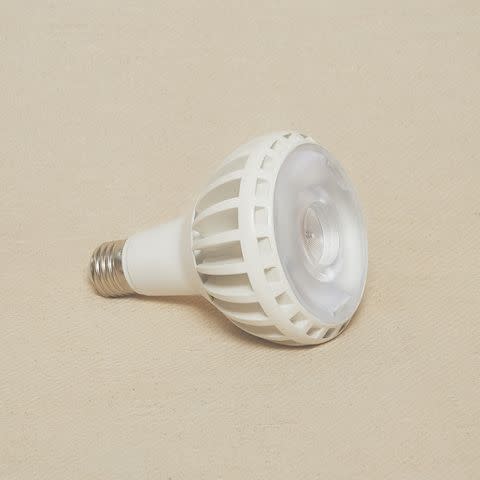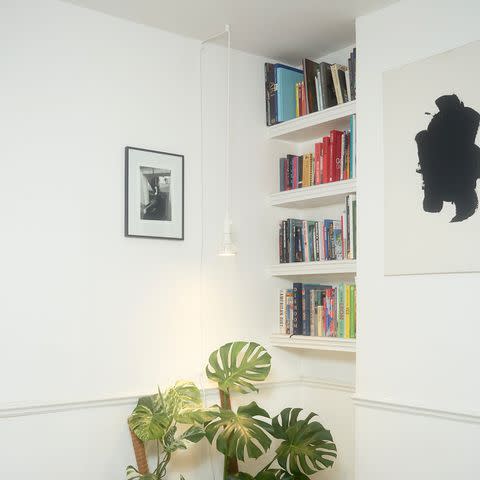Can You Grow Plants With an LED Light?
LED lights vs. LED grow lights: what's the difference?

The Spruce / Anastasiia Tretiak
Reviewed by Kathleen Miller
If you don’t have a ton of natural light in your home, you might start eyeing your LED lights to use as grow lights. Plants, even low-light plants, need light to grow, and artificial lights are an excellent way to ensure they’re getting what they need. But can you just use a regular LED light as a grow light, or does it have to be an LED grow light?
Generally, specially designed grow lights are best to make your plants thrive, for reasons that will be explained below. However, grow lights are more expensive. If you have strong LED lights such as workshop lights that emit light with a similar light spectrum and intensity as grow lights, you might be able to use those.
Here's what you need to know about growing plants with regular LED lights vs. LED grow lights.
Meet the Experts
Lorenzo Cadoux-Hudson is the founder of Grow Gang, a UK-based company that created a stylish and stylish and efficient grow light.
Justin Hancock is a horticulturist at Costa Farms.
The 12 Best Grow Lights of 2024, Tested and Reviewed
What Is an LED Light?
“LED is a semiconductor device that emits light when an electrical current is passed through it,” explains Cadoux-Hudson. “LED technology has been around for a long time, but it wasn’t until more recently that their costs have fallen significantly, and their efficiency increased, making them the preferred choice for general lighting.”

Regular LED Light vs. LED Grow Light
"The main difference between LED grow lights and regular LED lights is the wavelengths of light they put out. LED grow lights produce a wider spectrum of wavelengths than the traditional LED or fluorescent lights," says Hancock. "And depending on the type of plant light, it may also be more intense (produce more lumens) than a non-plant light.” Seedlings and young plants require grow lights with 50 to 75 lumens per square foot; larger plants need more lumens depending on the type of plant.
LED grow lights use a broader light spectrum than regular LED light to mimic natural sunlight. They include specific amounts of blue, white, green and red visible light as well as other non-visible spectrums such as infrared (IR) and ultraviolet (UV). The best photosynthesis wavelengths on the visible light spectrum occur in the blue range (425 to 450 nanometers) and the red range (600 to 700 nanometers). Regular LED lights, on the other hand, lack many of the wavelengths needed for plant growth; the light they produce is only good for illumination.
“LED grow lights mimic the role the sun has in photosynthesis. Full-spectrum LED grow lights emit a unique spectrum across all colors including red, green, and blue to help plants accelerate in all growth stages," says Cadoux-Hudson.
Every type of light has a different role in plant growth. Blue light encourages vegetative leaf growth. The combination of blue and red light helps with flowering. Green light, although it is the least efficiently used color of light in the visible light spectrum still plays a role in photosynthesis; it helps with leaf growth on lower parts of the plant because it penetrates the canopy better.
Special growth lights also have a higher wattage than regular LED lights and they use that wattage to produce lights in the spectrum that is the most conducive to plant growth, which is not the white and yellow light used by standard lights for lighting purposes. The wattage of LED grow lights ranges between 25 to 50 watts per square foot for foliage plants. Flowering plants may require a higher wattage of 40 to 60 watts per square foot.
Can I Use a Regular LED Light for Plants?

If you want your plants to thrive, it is not recommended to use a regular LED light in an indoor setting where the natural light is not sufficient. The plants won’t deteriorate right away but over time, they will show signs of light depravation and possibly stop to grow. The more amount of full-spectrum light (i.e. natural light) a plant needs to thrive, the more dramatic the effects of insufficient light will be.
"However, if you happen to have a full-spectrum LED light with high light intensity, such as a workshop light, it has a good color range for plant growth," says Hancock. "Your plant won’t mind if it’s not a specially designed plant light or a less expensive and more utilitarian light source, as long as it has the light spectrum needed for photosynthesis."
Selecting a Grow Light
When buying an LED light for your plants, look for one that has a PAR spectrum (Photosynthetically Active Radiation) — this is the range of 400 to 700 nanometers that mimics sunlight and helps plants with photosynthesis. Other selection criteria are wattage and lumens. All this information is typically included in the product description or on the package.
The Bottom Line
Ideally, you’d use a special LED grow light for your plants. While they require an initial investment, they are the most energy-efficient way to provide your indoor plants with full-spectrum light. If you already have other full-spectrum LED lights in your home, they can serve as a viable alternative.
Tips for Growing Plants With Grow Lights
Here are a few tips for when and how to use grow lights for your indoor plants:
When placing a plant in a location with insufficient natural light, use a grow light from the beginning. Bringing a sickly, light-deprived plant back to health later is usually more difficult.
Always match the grow light to the plant’s light requirements. Seedlings, young plants, and plants grown for their foliage need less light than flowering plants.
Don't place the light too close to your plant. Many grow lights have adjustable heights so as the plants grow, you are able to change the distance.
Set the timer of the grow lights according to the light conditions and the type of plants you are growing. If the plant is not getting any natural light, set the time for 8 to 16 hours to mimic the amount of natural sunlight. Six to eight hours of direct sunlight between the hours of 10 a.m. and 4 p.m. corresponds to "full sun" for outdoor plants.
Although LED lights emit very little heat, make sure to water seed starts or seedlings regularly to keep the soil evenly moist, as they tend to dry out quickly under the intense light.
How to Pick Out Grow Lights for Succulents
Frequently Asked Questions
What plants benefit from extra light?
Any plant that is not in a place with ideal light conditions benefits from extra light. That includes indoor plants that like direct sunlight as well as plants grown from seed indoors.
How much light does a plant need each day?
That entirely depends on the light requirements of the plant and how much natural light it gets where you placed it. If that turns out to be not sufficient, give it between 4 and, in extreme cases where it does not get any natural light, up to 16 hours of light every day.
Do I need a grow light to start seeds?
Unless you have a large, south- or west-facing window, a sun-drenched sunroom or a greenhouse, you need grow lights to start seeds indoors. Some seeds need light to germinate and young seedlings need lots of light, otherwise they will get weak and leggy.
Read the original article on The Spruce.

